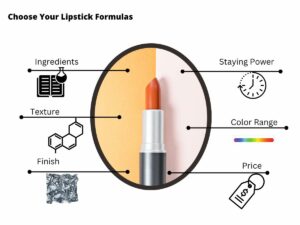Do you love lipstick so much that you want to create your own lipstick line? But you don’t know where to begin? Worry no more, because we got you covered.
This blog post presents a straightforward 10 easy step process for starting your own lipstick line. We will guide you through everything from conducting market research to successfully launching and promoting your products. By following our easy-to-follow guide, you can develop a lipstick line that truly sets itself apart in the market.
Read more to know the process and get ready to make your lipstick line.
1. Conduct Market Research
Before pursuing a lipstick business venture, it’s essential to make sure the numbers work. Do your research to get a comprehensive understanding of the cosmetics industry and find points in the market where you could fill a gap with your own lipstick brand. With a market worth over $530 billion, make sure the figures indicate that you can secure a share of the spending. I recommend taking these key considerations for effective market research:
#1 Identify Your Target Market
Determine the demographic and psychographic characteristics of your ideal customer. For example, this includes factors such as age, gender, income, lifestyle, and values.
#2 Analyze The Competition
Identify other hair product lines that are currently on the market and analyze their strengths, weaknesses, and unique selling propositions.
#3 Survey Potential Customers
Surveying potential customers can provide valuable insights into their preferences and needs. Here are some examples of survey methods
- Online Surveys: Conducting surveys online is an effective way to reach a large audience quickly and cost-effectively. You can use survey tools such as SurveyMonkey or Google Forms to create and distribute your survey.
- In-Person Surveys: Conducting in-person surveys at events or in retail stores can help you reach customers who are already interested in beauty and cosmetics. You can provide incentives such as free samples or discounts to encourage participation.
- Focus Groups: Conducting focus groups with a small group of people can provide in-depth insights into their opinions, attitudes, and behavior regarding your products. You can ask questions, observe their reactions, and receive feedback in real-time.
- Social Media Surveys: Conducting surveys on social media platforms such as Instagram or Twitter can help you reach a large audience and gain valuable insights into their preferences and opinions. You can use polls or surveys built-in on social media platforms, or create a survey link to share with your audience.
#4 Analyze Industry Trends
Understanding the current and emerging trends can help you create products that meet the needs and preferences of your target audience. Use this information to inform your product development, branding, and marketing strategies, and to create a product that meets the needs of your target audience.

2. Develop Your Product Line
After intensive market research, it is time to develop your product line. The goal is to create a product line that meets the needs and preferences of your target customers, aligns with your brand identity, and establishes your business as a leader in your industry. Here are some tips to take note of developing your product line.

#1 Select A Niche
To differentiate your product line from others on the market, it’s crucial to select a specific niche or focus area. You can also decide on the type of lipstick you want to create, such as vegan, cruelty-free, or organic. I suggest that you keep an eye on the latest trends in your industry and identify gaps or opportunities that align with your brand.
Here’s a sample chart that shows the profitability, and competition level of different niches to consider when developing your product line:
| Niches |
Target Audience |
Product Features |
Average Price Range |
Profitability |
Competition Level |
| Vegan |
Environmentally conscious consumers, vegans, and vegetarians. |
No animal-derived ingredients, no animal testing, eco-friendly packaging. |
$15-$30 |
High. Vegan products have a higher profit margin due to their perceived value and premium pricing. |
Low to medium. While the demand for vegan products is increasing, there are still fewer players in this niche compared to mainstream beauty products. |
| Cruelty-free |
Animal lovers, consumers concerned about animal welfare, and those who prefer ethically sourced products. |
No animal testing, may contain animal-derived ingredients, eco-friendly packaging. |
$10-$25 |
Medium to high. Cruelty-free products have a higher perceived value and can command premium pricing. |
Medium. There are several established brands in this niche, but the competition is not as intense as mainstream beauty products. |
| Organic |
Health-conscious consumers, those with sensitive skin, and those concerned about environmental impact. |
No synthetic ingredients, no artificial fragrances or colors, eco-friendly packaging. |
$20-$50 |
High. Organic products command a premium price due to their perceived quality and benefits. |
High. The competition in this niche is intense, with several established brands offering organic products. |
| Bold Colors |
Fashion-forward consumers, makeup enthusiasts, and those looking for unique and eye-catching looks. |
Vibrant and bold colors, long-lasting, and highly pigmented. |
$10-$30 |
Medium. Bold colors can command a higher price due to their perceived value and quality. |
Medium to high. While there are fewer players in this niche compared to mainstream beauty products, the competition is still intense. |
| Long-wearing |
Busy professionals, those who work long hours, and those with active lifestyles. |
Long-lasting, smudge-proof, and transfer-resistant. |
$15-$35 |
High. Long-wearing products can command a premium price due to their perceived value and convenience. |
Medium. There are several established brands in this niche, but the competition is not as intense as mainstream beauty products. |
#2 Branding
Develop a unique brand identity that resonates with your target audience. Your brand should be distinct from other brands and clearly communicate your message. Here are some steps you can take to create a strong brand:
- Define your brand identity: Determine the values, mission, and vision of your brand. Consider what sets you apart from your competitors and the needs and preferences of your target audience.
- Develop a brand name and tagline: Create a name and tagline that accurately represents your brand and resonate with your target audience.
- Create a logo and visual identity: Design a logo and visual identity that reflects your brand values and communicates your message clearly. Use colors, typography, and imagery that are consistent with your brand’s personality and message.
- Create brand guidelines: Develop a set of guidelines that outline the tone, voice, and visual elements of your brand. This helps ensure consistency across all channels and touchpoints.
- Develop a brand story: Craft a compelling brand story that connects with your audience emotionally and communicates your brand values and mission.
#3 Conduct Market Testing
Test your product concepts with your target market to gauge their interest and solicit feedback. Make necessary changes based on the feedback you receive. Example testing methods are focus groups, in-store demos, online surveys, product sampling, social media polls, and in-person events.
3. Determine Your Target Audience
Determining your target audience is a crucial step in creating an effective marketing strategy. Your target audience is the group of people who are most likely to be interested in your product or service. I believe it is critical to understand their needs, preferences, and behaviors in order to create a marketing message that resonates with them. Here are some steps you can take to determine your target audience:
#1 Identify Demographic And Psychographic Characteristics
Determine the demographic characteristics of your ideal customer, such as age, gender, income, location, and occupation. Also, consider their psychographic characteristics, such as personality, values, lifestyle, and interests.
#2 Conduct Market Research
Conduct market research to gain insights into consumer preferences, behaviors, and trends. Use this information to identify gaps in the market and consumer needs that you can fill with your product.
#3 Analyze Competitor Products
Analyze the products and marketing strategies of your competitors to gain insights into what is working and what is not. Look for gaps in the market that you can fill with your product.
#4 Create Customer Personas
Create customer personas that represent your ideal customers, based on the insights you have gained. This will help you create a more focused and tailored marketing strategy. Here are some examples of customer personas that you can try:
- The Bold and Adventurous Buyer: This customer persona is likely to be young, adventurous, and open to trying new and bold lipstick colors. They are likely to be active on social media and enjoy sharing their beautiful looks with their followers.
- The Professional and Minimalist Buyer: This customer persona is likely to be older, professional, and prefer a more subtle and natural look. They value high-quality products and are willing to pay a premium for long-lasting lipstick that doesn’t require frequent touch-ups.
- The Environmentally-Conscious Buyer: This customer persona values sustainability and eco-friendliness in their purchasing decisions. They prefer lipsticks made with natural, organic, and cruelty-free ingredients, and eco-friendly packaging.
- The Trendy and Fashion-Forward Buyer: This customer persona is likely to be young and always up-to-date with the latest fashion and beauty trends. They are willing to experiment with new and trendy lipstick colors and formulations.
#5 Conduct Surveys And Focus Groups
Conduct surveys and focus groups with potential customers to gain feedback on your product and marketing strategy. This can help you gain insights into their preferences and needs.

4. Choose Your Lipstick Formulas
Lipstick formulas can vary greatly in terms of their ingredients, texture, finish, and staying power, so it’s important to consider your target audience’s preferences and needs when choosing your formulas. Here are some factors to consider when choosing your lipstick formulas:
#1 Ingredients
Consider using high-quality ingredients that are safe and gentle on the skin, such as natural and organic ingredients. I suggest that you try to consider offering vegan and cruelty-free options to appeal to a wider audience.
#2 Texture
Consider offering a variety of textures to appeal to different preferences. There are different types of lipstick textures that you can offer to cater to different preferences of your target audience. Here are some examples:
- Matte: Matte lipsticks have a flat, non-shiny finish and are usually opaque in color. They are popular for their long-lasting, high-impact color and often contain more wax and less oil than other formulas. They can be drying on the lips, so it’s important to use ingredients that are moisturizing.
- Glossy: Glossy lipsticks have a shiny finish and are usually more sheer in color than matte lipsticks. They can provide a more moisturizing feel on the lips than matte formulas and are generally easier to apply. They do not last as long as matte lipsticks and may require more frequent reapplication.
- Satin: Satin lipsticks have a finish that is between matte and glossy. They have a slight sheen to them and provide a more moisturizing feel than matte lipsticks. Satin lipsticks are often more comfortable to wear than matte lipsticks and have better staying power than glossy lipsticks.
- Metallic: Metallic lipsticks have a shimmery or glittery finish and are usually more sheer in color. They can provide a unique and eye-catching look that is popular for special occasions or events. Metallic lipsticks can be more drying on the lips than other formulas, so it’s important to use ingredients that are moisturizing.
- Creamy: Creamy lipsticks have a smooth and buttery texture and are usually more opaque in color. They provide a more moisturizing feel than matte lipsticks and have a shiny finish. Creamy lipsticks are easy to apply and can provide comfortable wear for those with dry lips.
Here’s a video for more information on lipstick texture:
#3 Finish
Consider offering a range of finishes, such as sheer, opaque, or metallic. The finish can affect the overall look of lipstick and appeal to different preferences.
#4 Staying Power
Staying power is an important factor to consider when selecting a lipstick formula, as it determines how long the lipstick will last without the need for touch-ups. I suggest that you should choose ingredients that provide good adhesion to the lips and prevent lipstick from smudging or fading.
#5 Color Range
Consider offering a wide range of colors to appeal to different preferences and skin tones. You can also consider creating customized shades that are unique to your brand.
#6 Price
Consider the cost of your formulas and determine a pricing strategy that is competitive while still allowing you to make a profit. Determining the right price for your lipstick is an important factor that can impact the success of your business.
By considering these factors , there is definitely no doubt that you can create the best lipstick formula. If you need help from experts and experienced professionals, Nako Cosmetics is here for you.

5. Develop Your Product Packaging
Developing your product packaging is an important part of creating a successful lipstick line. Your packaging should be attractive, functional, and aligned with your brand values. Here are some steps you can take to develop your product packaging:
#1 Determine Your Packaging Needs
Consider the size, shape, and design of your lipstick tube, as well as any additional packaging, such as boxes or bags. It should also meet any legal requirements and be suitable for the distribution channels that you plan to use.
#2 Develop A Design Concept
Create a design concept that reflects your brand identity and values. Consider factors such as color, typography, imagery, and messaging. A strong design concept can help your product stand out on store shelves, communicate your brand identity, and appeal to your target audience.
#3 Choose Your Packaging Materials
Select high-quality materials that are durable, attractive, and sustainable. Remember to research the available options and conduct cost-benefit analysis to determine the most suitable materials for your lipstick line. I suggest that you consider eco-friendly materials such as recycled or biodegradable materials.
#4 Determine Your Packaging Printing Method
Choose a printing method that produces high-quality, consistent results. There are various printing methods available for lipstick packaging, each with its own advantages and limitations. Here are some examples of common packaging printing methods:
- Offset printing: This is a popular printing method for high-quality, large quantity printing. It uses printing plates to transfer ink onto the packaging material. Offset printing is cost-effective for large quantity orders, and can produce sharp and vibrant colors.
- Flexographic printing: This is a popular printing method for printing on flexible packaging materials. It uses flexible printing plates to transfer ink onto the packaging material. Flexographic printing is cost-effective for high-volume orders and can produce good quality prints with fast turnaround times.
- Digital printing: This is a relatively new printing method that allows for high-quality printing on a variety of packaging materials. It does not require printing plates, making it ideal for small quantity orders and personalized prints. Digital printing can produce high-quality prints with intricate designs and variable data.
- Letterpress printing: This is an old-fashioned printing method that uses raised metal plates to transfer ink onto the packaging material. It is ideal for small quantity orders and produces a classic and elegant look. However, it can be expensive and is limited in terms of color options.
- Hot stamping: This is a popular printing method for creating metallic or holographic designs on packaging. It uses a heated die to transfer a thin layer of metallic foil onto the packaging material. Hot stamping can create a premium look and feel to the packaging.
#5 Test Your Packaging
Test your packaging extensively to ensure it meets your quality standards and is easy to use. Consider factors such as functionality, ease of opening, and durability.

6. Source For Manufacturers
Finding a reputable and high-quality manufacturer is a critical step in developing a successful lipstick line. Because the quality and consistency of your product depend on the expertise and reliability of the manufacturer. Here are some steps you can take to find and evaluate potential manufacturers:
#1 Conduct Research
Research different lipstick manufacturers and evaluate their reputation, experience, and capabilities. Consider online directories, industry associations, and trade shows as sources of information.
#2 Develop A List Of Potential Manufacturers
Based on your research, develop a list of potential manufacturers that meet your quality and quantity requirements. Evaluating each manufacturer and requesting samples can help you determine which manufacturer is the best fit for your lipstick line. I highly suggest that you should take your time in this process and make an informed decision to ensure that your product is of high quality and meets your desired specifications.
#3 Contact Potential Manufacturers
Reach out to potential manufacturers and ask about their services, pricing, and minimum order quantities. Provide them with your product specifications, such as color, texture, and packaging requirements.
#4 Evaluate Their Capabilities
Evaluate each manufacturer’s capabilities in terms of their production capacity, turnaround time, and quality control measures. Consider visiting their factory or requesting product samples to evaluate their product quality.
#5 Check Their Certifications
When choosing a manufacturer for your lipstick line, it’s important to check their certifications to ensure that they meet industry standards and are operating legally and ethically. Here are some examples of certifications you should look for when evaluating potential manufacturers:
- Good Manufacturing Practice (GMP) certification: GMP certification ensures that a manufacturer follows industry guidelines and standards for the production, testing, and quality control of products. GMP certification is important for ensuring that your lipstick line is produced in a safe and effective manner.
- ISO certification: The International Organization for Standardization (ISO) certification ensures that a manufacturer has implemented a quality management system that meets industry standards. This certification can ensure that your product is consistently produced to high-quality standards.
- Organic certification: If your lipstick line contains organic ingredients, look for a manufacturer that is certified by the USDA National Organic Program or other certification bodies to ensure that the ingredients are sourced and processed according to organic standards.
- Ethical sourcing certification: If your lipstick line contains ingredients that are sourced from other countries, look for a manufacturer that has certifications related to ethical sourcing, such as Fairtrade or Rainforest Alliance certification.
- FDA registration: If you plan to sell your lipstick line in the US, look for a manufacturer that is registered with the Food and Drug Administration (FDA) to ensure that they are compliant with federal regulations.
By sourcing the right manufacturer, you can ensure that your lipstick line meets your desired quality standards, is cost-effective, and appeals to your target audience. Working with a reputable manufacturer can also help you streamline your production processes, manage your time effectively, and build a long-term partnership that can support your business growth. If you require professional assistance, Nako Cosmetics is the best manufacturer you can rely on.

7. Obtain Necessary Licenses and Permits
Obtaining the necessary licenses and permits, you can legally sell your products and avoid fines or other legal consequences. Depending on your location, you may need to obtain specific licenses and permits to legally sell your products. Here are some points you can take to obtain the necessary licenses and permits:
#1 Research The Requirements
Research the licensing and permit requirements for cosmetics manufacturers and retailers in your location. I suggest that you contact your local or state government agencies or check their websites for information.
#2 Apply For A Business License
Apply for a business license that permits you to sell cosmetics or operate a manufacturing business. This may require registering your business with your local government and obtaining a tax identification number.
#3 Maintain Compliance
Ensure that you maintain compliance with all relevant regulations and standards. It’s important to work with a manufacturer that is transparent about their manufacturing process and can provide documentation to support their compliance efforts. For example, this may involve regular inspections, record keeping, and reporting.

8. Establish Sales and Distribution Channels
Establish sales and distribution channels that align with your brand values and reach your target audience. This involves determining how you will sell your products and get them into the hands of your customers. Here are some steps that I suggest where you can establish sales and distribution channels:
#1 Determine Your Sales Strategy
Think of sales strategies where you can promote and sell your lipstick line to a wider audience and generate sales. It’s important to choose the strategies that align with your target audience and your brand values. Here are some examples of sales strategies that you can use to promote and sell your lipstick line:
- Online sales: Create a website or online store to sell your lipstick line. Use digital marketing strategies such as search engine optimization (SEO), pay-per-click (PPC) advertising, and social media marketing to drive traffic to your online store.
- Wholesale sales: Sell your lipstick line in bulk to retailers or distributors who can then sell your products in their stores. Attend trade shows and industry events to meet potential wholesale buyers.
- Direct sales: Sell your lipstick line directly to consumers through events such as pop-up shops, trunk shows, or other retail events. This can be a great way to build brand awareness and generate buzz.
- Subscription sales: Offer a subscription service where customers receive a new lipstick every month or quarter. This can be a good way to build brand loyalty and generate recurring revenue.
- Influencer partnerships: Partner with social media influencers or beauty bloggers to promote your lipstick line. This can help increase brand awareness and reach new audiences.
#2 Identify Potential Retail Partners
Identify potential retail partners that align with your brand values and target audience. Consider factors such as customer demographics, location, and brand fit.
#3 Develop A Sales Pitch
Develop a sales pitch that communicates your brand’s unique value proposition and product benefits. Be prepared to pitch your brand to potential retail partners and distributors.
#4 Create A Pricing Strategy
Determine your pricing strategy based on your production costs, packaging, and competition. Ensure that your pricing is competitive while still allowing you to make a profit.
#5 Develop A Distribution Strategy
Determine how you will get your products into the hands of your customers. Consider options such as using a third-party logistics provider or shipping products directly to customers.

9. Develop Marketing And Promotion Strategies
Developing marketing and promotion strategies is an important step in launching your lipstick line. Effective marketing can help you build brand awareness, reach your target audience, and drive sales. Here are some tips that you can take to develop your marketing and promotion strategies:
#1 Determine Your Unique Selling Points
Identify the unique features and benefits of your lipstick line that set it apart from other products on the market. This will help you develop messaging that appeals to your target audience.
#2 Develop A Marketing Plan
Create a marketing plan that outlines the tactics you will use to reach your target audience. It could be advantageous to consider channels such as social media, email marketing, influencer partnerships, and paid advertising.
#3 Measure And Optimize Your Marketing
Use analytics and tracking tools to measure the success of your marketing efforts and optimize your strategy over time. Here are some examples of analytics and tracking tools that you can use to measure the effectiveness of your marketing and promotion strategies for your lipstick line:
- Google Analytics: Google Analytics is a free tool that provides insights into your website traffic, user behavior, and conversions. It can help you track the performance of your online store and measure the impact of your digital marketing strategies.
- Social media analytics: Most social media platforms, including Facebook, Instagram, and Twitter, provide analytics tools that allow you to track the performance of your social media content. These tools can provide insights into your audience, engagement rates, and follower growth.
- Email marketing analytics: Email marketing platforms, such as Mailchimp and Constant Contact, provide analytics tools that allow you to track the performance of your email campaigns. This can include open rates, click-through rates, and conversion rates.
- Customer relationship management (CRM) software: CRM software, such as HubSpot or Salesforce, can help you track customer interactions and manage customer data. This can help you identify patterns and trends in customer behavior and inform your marketing strategies.
- A/B testing tools: A/B testing tools, such as Optimizely or VWO, can help you test and optimize different marketing strategies, such as landing pages or email campaigns. This can help you identify which strategies are most effective in driving conversions.

10. Launch Your Lipstick Line
Congratulations on making it to the final step! Launching your lipstick line is an exciting time, and it’s important to make sure everything is in place for a successful launch. Here are some tips that you can take to launch your lipstick line:
#1 Finalize Your Products
Make sure your products meet your quality standards and are ready to be sold. I strongly advise that you should conduct final product testing and ensure that all packaging and labeling is correct.
#2 Build Buzz
Create excitement around your launch by promoting it on social media, to your email list, and to your network. Consider offering a pre-sale or early bird discount to incentivize customers to make a purchase.
#3 Launch Events
Host a launch event to generate buzz and get people excited about your products. Consider partnering with influencers or retailers to increase attendance and visibility. Here are some other examples where you can launch your lipstick brand:
- Online store: Launch your lipstick line on your own website or on an e-commerce platform like Amazon or Etsy. This allows you to reach a wider audience and sell your products around the clock.
- Retail stores: Sell your lipstick line in retail stores that cater to your target audience. Approach local boutiques or larger department stores to inquire about wholesale opportunities.
- Social media: Use social media platforms like Instagram, Facebook, and TikTok to promote and sell your lipstick line. You can leverage influencer partnerships or create engaging content to reach new customers.
#4 Manage Inventory
Ensure that you have enough inventory on hand to fulfill orders and meet demand. Consider using a third-party logistics provider to manage inventory and shipping.
#5 Monitor And Respond To Feedback
Monitor customer feedback and respond to inquiries and concerns in a timely manner. Use customer feedback to improve your products and customer experience.
#6 Continuously Evaluate And Optimize
Continuously evaluate your sales and marketing performance, and make necessary adjustments to optimize your strategy over time. By continuously evaluating and optimizing your lipstick line, you can ensure that it stays relevant and competitive in the marketplace.

Dive Deeper Into Our Resources
Looking for more diverse product options? Browse through our handpicked selections:
Still haven’t found what you’re looking for? Don’t hesitate to contact us. We’re available around the clock to assist you.
11. Conclusion
Therefore, creating a lipstick link might be overwhelming. But by following these 10 easy steps, and staying true to your brand values and focusing on quality, you can launch a successful lipstick line and grow your business.
With perseverance, hard work, and a solid business plan, you can successfully launch your lipstick line and build a loyal customer base. If you need professional help in creating your own lipstick line, don’t hesitate to contact Nako Cosmetics.









